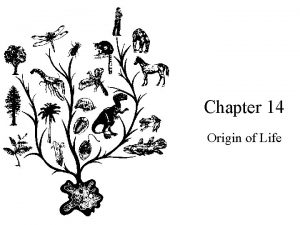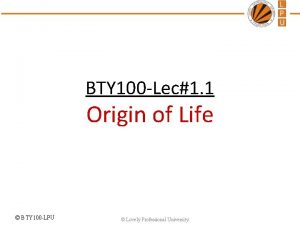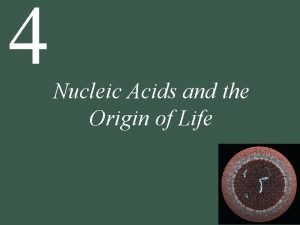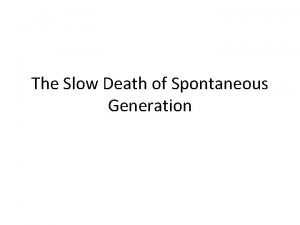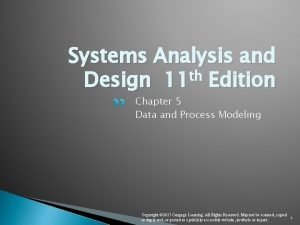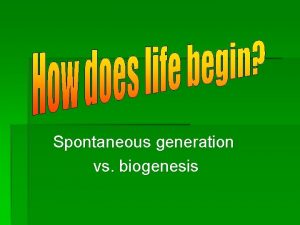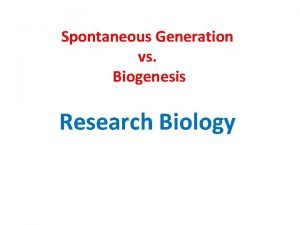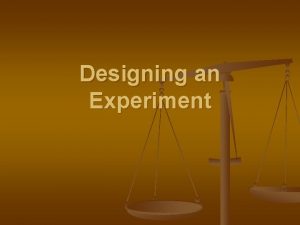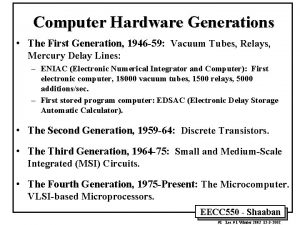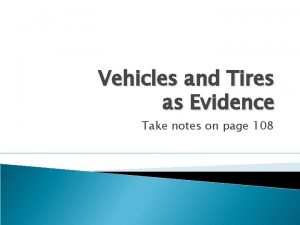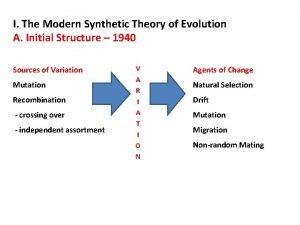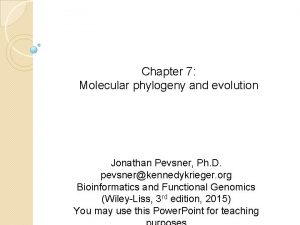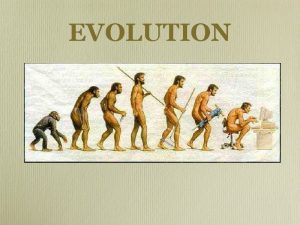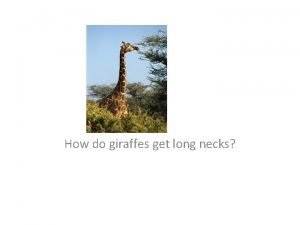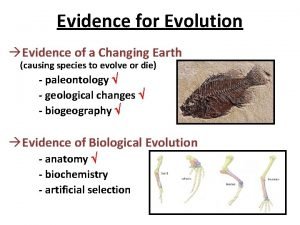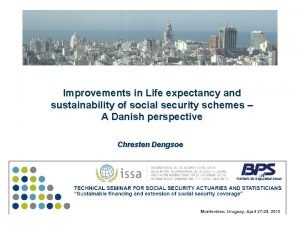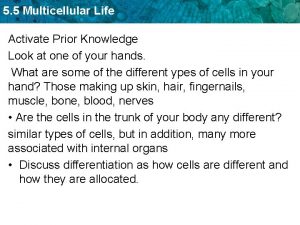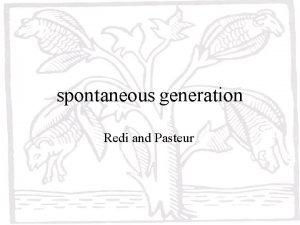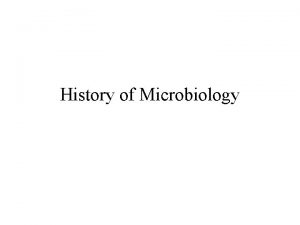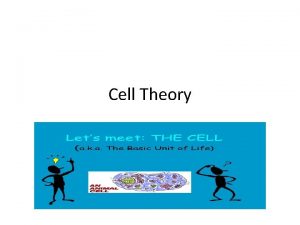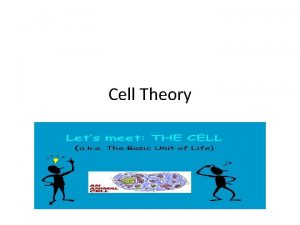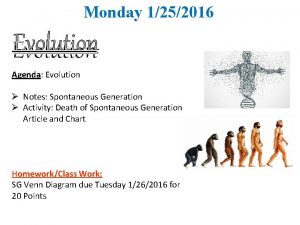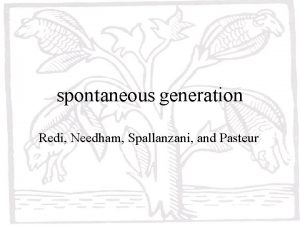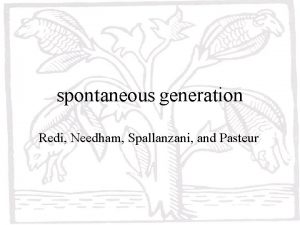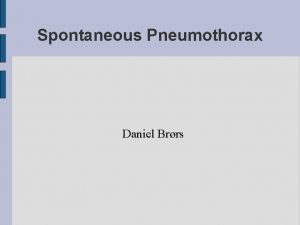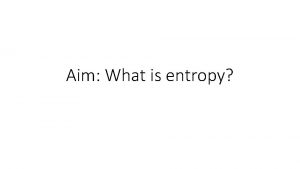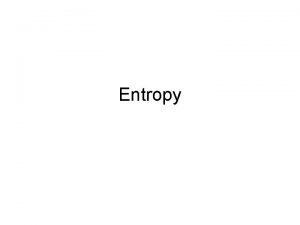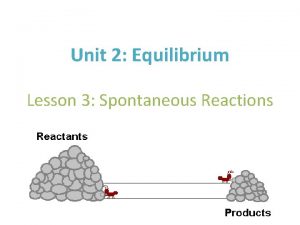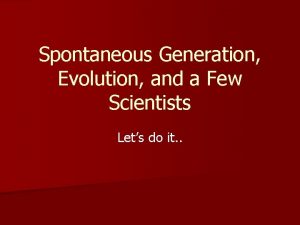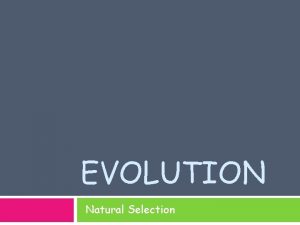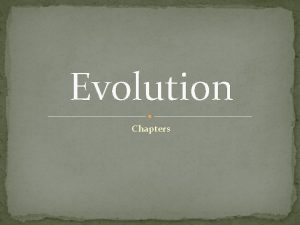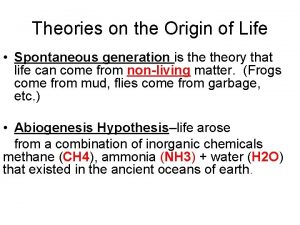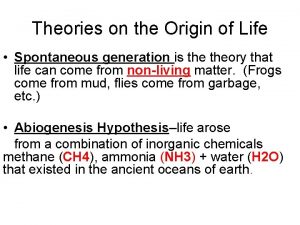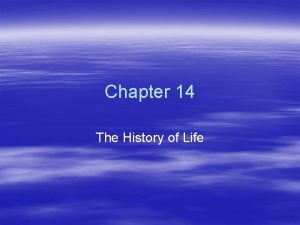Evolution Notes Chapters 14 17 Spontaneous Generation Life






























- Slides: 30

Evolution Notes Chapters 14 -17

Spontaneous Generation • Life generates from Non-Living material – People believed this was true until the late 19 th century – "Law of Biogenesis, " which states that life only comes from previously existing life

Francesco Redi (1626 -1697) • Tried to disprove spontaneous generation using maggots and meat. (see p. 261)

Lazzaro Spallanzani (1729 -1799) • Boiled broth experiment: showed that microbes would not show up in broth that was boiled and sealed (See p. 262). • People were still not convinced

Louis Pasteur (1822 -1895) • He finally settled the dispute over spontaneous generation by using a curved necked flask. (see p. 263)

Pasteur’s other contributions • He solved the mysteries of rabies, anthrax, chicken cholera, and silkworm diseases, and contributed to the development of the first vaccines. • He described the scientific basis for fermentation, wine-making, and the brewing of beer

How do we learn about the past • Earth’s age: estimated at 4. 6 billion years • Radioactive dating: Most elements have several isotopes (same atomic #, different mass) and some of them decay (give off particles or radiant energy or both) and become a “daughter element”

HALF-LIFE • The time it takes for half of the radioactive material to decay is called half-life (Carbon-14 is radioactive and becomes the daughter element N-14) • It takes 5, 730 years for one ½ life of carbon-14

How ½ lives are estimated • The amount of the original material is compared to the amount of the daughter material to determine how many half-lives have passed. This tells scientists how old the organism is (or rock layer)

Earliest forms of life • Had to be anaerobic (low oxygen in the atmosphere) • The oldest microfossils found are prokaryotic (no nucleus) • Most likely used chemosynthesis (energy is obtained from inorganic substances)

Bacteria • Archaebacteria Living today: bacteria that thrive in harsh environments: like earth’s beginning • Cyanobacteria Also alive today: they are capable of photosynthesis About 3 billion years ago organisms like these started putting O 2 in our atmosphere

The first Eukaryotes(1/5) • Endosymbiosis: theory that aerobic prokaryote invaded (like a parasite) inside larger anaerobic prokaryotes. This mutually beneficial relationship evolved into the mitochondria of eukaryotic cells

Fossils • Law of Superposition = rock layers are deposited on other rock layers; therefore older rock is found below younger rock – Relative age: tells that a fossil is younger or older than another fossil Absolute age: tells the exact age of a fossil

Geologic History Mass extinctions: brief periods where large numbers of species disappeared from the rock record: these events defined the different periods and eras of the past

Geologic ages • Precambrian (over ½ billion years ago) – Prokaryotes, then eukaryotes • Paleozoic (500 -245 million years ago) – Invertebrates – Fish – Amphibians – Land plants – reptiles

Geologic ages continued • Mesozoic era (245 – 65 million yrs ago) – Dinosaurs dominate, but become extinct at the end of this era – Mammals arise – Birds arise

Geologic ages continued • Cenozoic era (65 mya – present) – Modern mammals arise – Hominids show up

Jean Baptiste de Lamarck 1829) (1744 - • Developed idea of evolution before the time of Darwin. He explained that species changed by the inheritance of Acquired characteristics • He thought that giraffe Ancestors stretched their Necks to reach the trees Producing offspring with Longer necks

Charles Darwin (1809 -1882) • Sailed on the HMS Beagle • Went to the Galapagos islands – Studied various species of finches along with thousands of other species • Wrote the book “On the Origin of Species” which explained evolution • He coined the term “Natural Selection” (survival of the fittest)

Evidence of Evolution • Homologous features: similar features that originated from a common ancestor

Evidence of Evolution • Analogous features: features that are similar in function but do not come from common ancestry: the wings of bats, birds and insects

Evidence of Evolution • Vestigial structures: structures that may have served a purpose at one time, but no longer have a purpose that is known: • Examples: human tailbone, wisdom teeth and appendix; Pelvic bone in whales; skeletal limbs and pelvis in boa constrictor

Evidence of Evolution • Embryology: humans, pigs, reptiles and birds all have similar stages of embryological growth

Evidence of Evolution • DNA similarities: closer related organisms share more amino acid sequences than more distantly related organisms

Patterns of evolution • Coevolution – The change of 2 or more species in close association with each other • Bats or hummingbirds evolved with the flowers that they pollinate

Convergent evolution • When two dissimilar species evolve to become more similar – Sharks and dolphins have similar structures that nature selected for them even though their origin is very different – Analogous features are the result of convergent evolution

Divergent evolution • Two or more related populations or species become more and more different

Adaptive radiation • Type of divergent evolution • One species (like the Galapogos Finches) become different because of different environmental conditions (like food resources) that they must adapt to

• Divergent evolution caused by humans – Different breeds of dogs were selected and bred from wolves – Traits in horses are selected and bred – Various plants are cultivated with special traits Artificial selection

 Louis lerman experiment
Louis lerman experiment Disproving spontaneous generation
Disproving spontaneous generation Disproving spontaneous generation
Disproving spontaneous generation The slow death of spontaneous generation
The slow death of spontaneous generation Spontaneous generation in data flow diagram
Spontaneous generation in data flow diagram Whats spontaneous generation
Whats spontaneous generation Describe data and process modeling concepts and tools
Describe data and process modeling concepts and tools Whats spontaneous generation
Whats spontaneous generation Spontaneous generation vs biogenesis
Spontaneous generation vs biogenesis Aristotle spontaneous generation
Aristotle spontaneous generation John needham experiment main idea
John needham experiment main idea Second generation vs first generation antipsychotics
Second generation vs first generation antipsychotics Lord you are good and your mercy endureth
Lord you are good and your mercy endureth Computer hardware generation
Computer hardware generation Evidence for evolution doodle notes
Evidence for evolution doodle notes Modern synthetic theory of evolution notes
Modern synthetic theory of evolution notes Neutral theory of molecular evolution notes
Neutral theory of molecular evolution notes Lamarck theory of evolution notes
Lamarck theory of evolution notes Organism
Organism Evolution of shrm notes
Evolution of shrm notes Modern theory of evolution
Modern theory of evolution Lamarck theory of evolution
Lamarck theory of evolution Life of pi chapters 15-28 summary
Life of pi chapters 15-28 summary Wisc
Wisc Life expectancy evolution
Life expectancy evolution 17-3 evolution of multicellular life
17-3 evolution of multicellular life Life expectancy in 1500
Life expectancy in 1500 Section 17-3 evolution of multicellular life answer key
Section 17-3 evolution of multicellular life answer key Star life cycle 1-10
Star life cycle 1-10 You can dream but don't neglect the execution meaning
You can dream but don't neglect the execution meaning Ericsson hellas
Ericsson hellas
